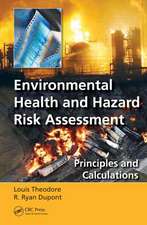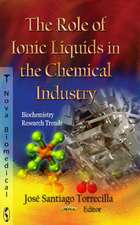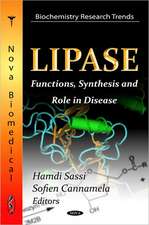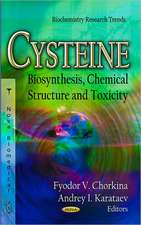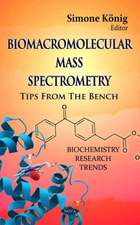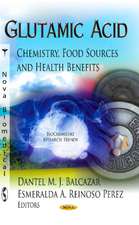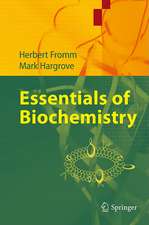Advanced Methods in Protein Microsequence Analysis
Editat de Brigitte Wittmann-Liebold, Johann Salnikowen Limba Engleză Paperback – 17 noi 2011
Preț: 650.37 lei
Preț vechi: 765.14 lei
-15% Nou
Puncte Express: 976
Preț estimativ în valută:
124.46€ • 129.46$ • 102.75£
124.46€ • 129.46$ • 102.75£
Carte tipărită la comandă
Livrare economică 14-28 aprilie
Preluare comenzi: 021 569.72.76
Specificații
ISBN-13: 9783642715365
ISBN-10: 3642715362
Pagini: 436
Ilustrații: X, 424 p.
Dimensiuni: 170 x 244 x 23 mm
Greutate: 0.69 kg
Ediția:Softcover reprint of the original 1st ed. 1986
Editura: Springer Berlin, Heidelberg
Colecția Springer
Locul publicării:Berlin, Heidelberg, Germany
ISBN-10: 3642715362
Pagini: 436
Ilustrații: X, 424 p.
Dimensiuni: 170 x 244 x 23 mm
Greutate: 0.69 kg
Ediția:Softcover reprint of the original 1st ed. 1986
Editura: Springer Berlin, Heidelberg
Colecția Springer
Locul publicării:Berlin, Heidelberg, Germany
Public țintă
ResearchCuprins
1 Separation and Amino Acid Analysis of Proteins and Peptides for Microsequencing Studies.- 1.1 Separation of Peptides.- 1.2 High Performance Liquid Chromatography of Proteins.- 1.3 Two-Dimensional Polyacrylamide Gel Electrophoresis in Stamp-Sized Gels.- 1.4 Amino Acid Analysis by High Performance Liquid Chromatography of Phenylthiocarbamyl Derivatives.- 1.5 High Sensitivity Amino Acid Analysis Using DABS-C1 Precolumn Derivatization Method.- 2 Manual and Solid-Phase Microsequencing Methods.- 2.1 Modern Manual Microsequencing Methods.- 2.2 Manual Microsequence Determination of Proteins and Peptides with the DABITC/PITC Method.- 2.3 Solid-Phase Microsequencing: Procedures and Their Potential for Practical Sequence Analysis.- 2.4 Automated Solid-Phase Microsequencing Using DABITC, On-Column Immobilization of Proteins.- 3 Gas-Phase and Radio-Sequence Analysis.- 3.1 Gas-Phase Sequencing of Peptides and Proteins.- 3.2 Water Contents and Quality Criteria of Microsequencing Chemicals. Preliminary Results of a Reevaluation.- 3.3 An Improved Gas-Phase Sequenator Including On-Line Identification of PTH Amino Acids.- 3.4 Amino-Acid Composition and Gas-Phase Sequence Analysis of Proteins and Peptides from Glass Fiber and Nitrocellulose Membrane Electro-Blots.- 3.5 Protein Blotting from Polyacrylamide Gels on Glass Microfiber Sheets: Acid Hydrolysis and Gas-Phase Sequencing of Glass-Fiber Immobilized Proteins.- 3.6 Radio-Sequence Analysis; an Ultra-Sensitive Method to Align Protein and Nucleotide Sequences.- 4 Phenylthiohydantoin Identification, On-Line Detection, Sequences Control, and Data Processing.- 4.1 Conversion of Anilinothiazolinone to Phenylthiohydantoin Derivatives and Their Separation by High Pressure Liquid Chromatography.- 4.2 The Use of On-Line High Performance LiquidChromatography for Phenylthiohydantoin Amino-Acid Identification.- 4.3 Device Control, Data Collection, and Processing in Protein Micro-Sequencing and Amino-Acid Analysis.- 5 Analysis of Cysteine Residues in Proteins.- 5.1 Analysis of Cyst(e)ine Residues, Disulfide Bridges, and Sulfhydryl Groups in Proteins.- 5.2 Identification of the Heme-Binding Cysteines in Cytochromes c Without Radioactive Labeling.- 5.3 Micro-Isolation of Polypeptides Precolumn Labeled with Hydrophobic Chromophore.- 6 Methods of Analyzing Protein Conformation.- 6.1 Synthetic Immunogens for Secondary Structure Assignment: Conformational Sequencing of Proteins with Antipeptide Antibodies.- 6.2 Aspartyl-tRNA Synthetase-Induced Aspartylation of Proteins: a Fingerprint Approach to Map Accessible Domains in Protein.- 7 Strategies and Specific Examples of Sequencing Proteins and Peptides.- 7.1 Strategies of Biochemical Characterization of Hormonal Peptides.- 7.2 Use of a Metalloproteinase Specific for the Amino Side of Asp in Protein Sequencing.- 7.3 Primary Structure of Rabbit Apolipoprotein A-I. High Performance Liquid Chromatography, PTC-Amino Acid Analysis, and Microsequencing.- 7.4 Sequence Analysis of Complex Membrane Proteins (Cytochrome c Oxidase).- 7.5 Sequence Studies on the ?-, ?-, and ?-Chains of Elongation Factor 1 from Artemia. Some Practical Notes.- 8 Alternative Sequencing Techniques for Elucidation of Peptide and Protein Structures.- 8.1 RNA Sequencing.- 8.2 Synthetic Genes as a Powerful Tool for Protein Structure-Function Analysis.- 8.3 Generation and Interpretation of Fast Atom Bombardment Mass Spectra of Modified Peptides.



